Business Strategy Analysis of Toyota: Porter's Five Forces and Ansoff
VerifiedAdded on 2021/06/14
|21
|6420
|83
Report
AI Summary
This report provides a comprehensive analysis of Toyota's business strategy, evaluating its competitive forces using Porter's Five Forces model and exploring growth strategies with the Ansoff Matrix. The report begins with a brief profile of Toyota, including its mission, vision, and objectives. It then delves into the importance of understanding the competitive environment and identifies key stakeholders. Applying Porter's Five Forces, the report assesses the threats of new entrants, the bargaining power of suppliers and buyers, and the intensity of rivalry, offering insights into how Toyota can navigate these forces. Furthermore, the report utilizes the Ansoff Matrix to devise strategies for improving competitive advantage and market position, followed by an evaluation of strategic directions and recommendations for the most appropriate strategies. Finally, the report applies various theories, concepts, and models to interpret and devise strategic planning for Toyota, culminating in a strategic management plan with tangible priorities and objectives. The report concludes with a summary of the findings and recommendations.
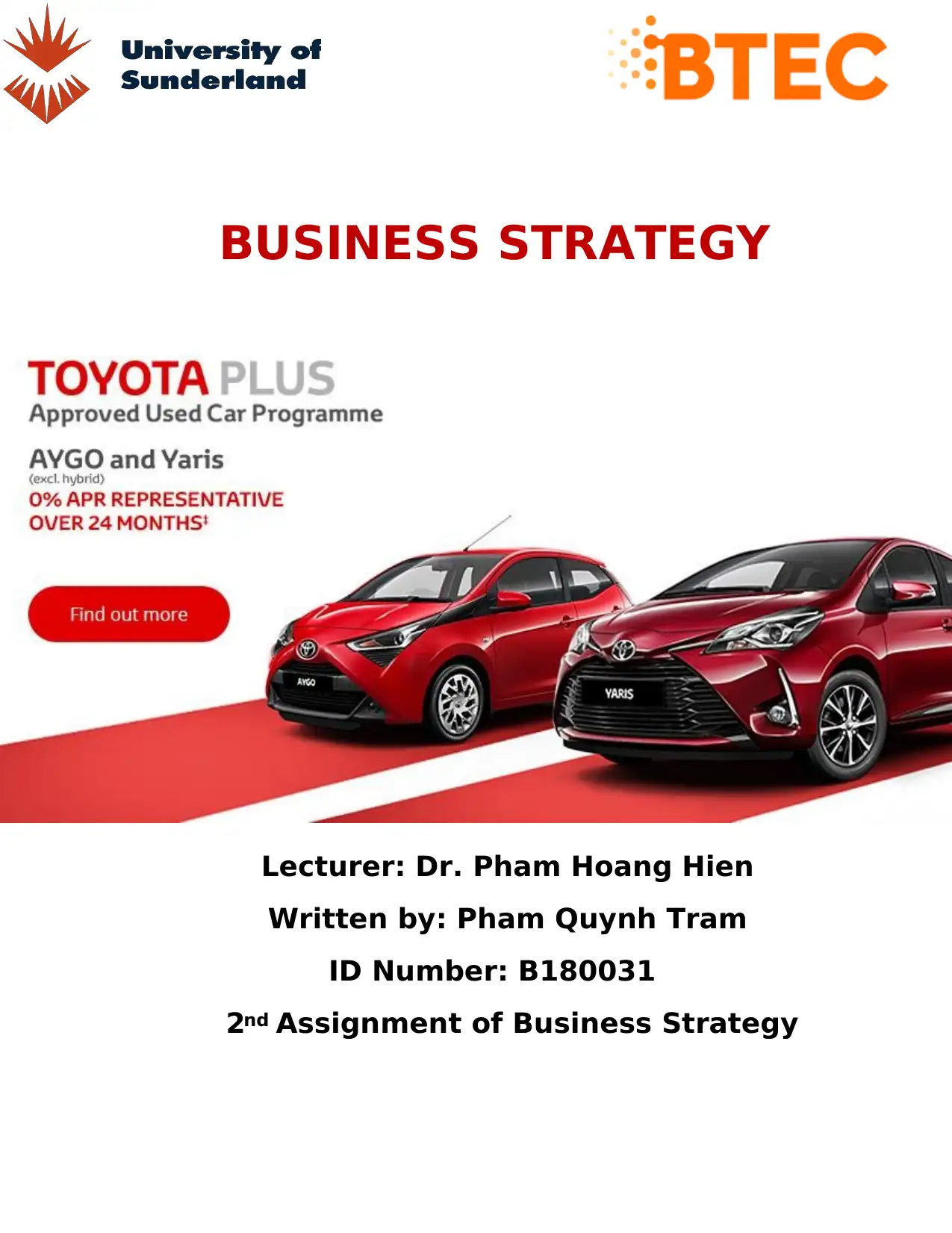
BUSINESS STRATEGY
Lecturer: Dr. Pham Hoang Hien
Written by: Pham Quynh Tram
ID Number: B180031
2nd Assignment of Business Strategy
Lecturer: Dr. Pham Hoang Hien
Written by: Pham Quynh Tram
ID Number: B180031
2nd Assignment of Business Strategy
Paraphrase This Document
Need a fresh take? Get an instant paraphrase of this document with our AI Paraphraser
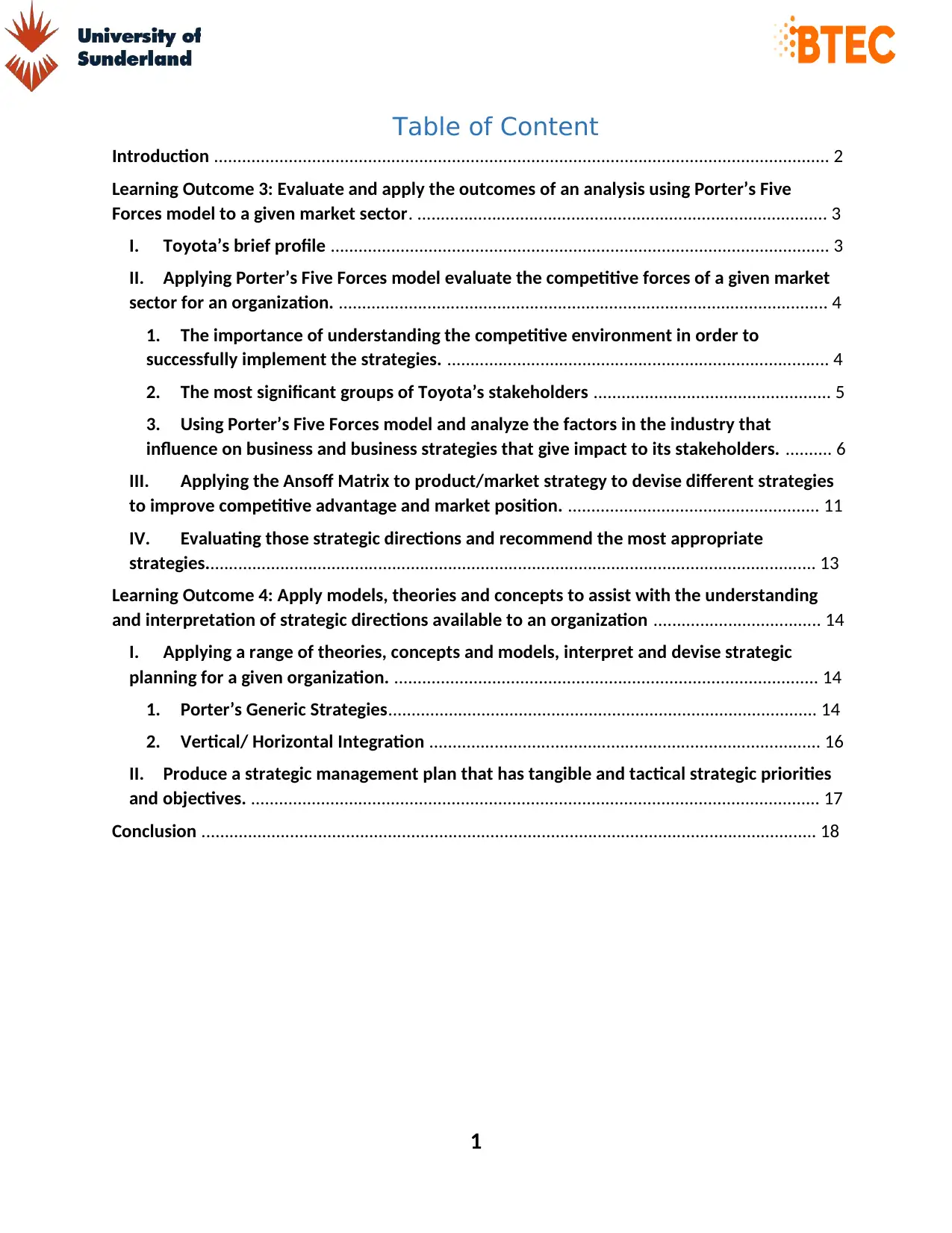
1
Table of Content
Introduction .................................................................................................................................... 2
Learning Outcome 3: Evaluate and apply the outcomes of an analysis using Porter’s Five
Forces model to a given market sector. ........................................................................................ 3
I. Toyota’s brief profile ........................................................................................................... 3
II. Applying Porter’s Five Forces model evaluate the competitive forces of a given market
sector for an organization. ......................................................................................................... 4
1. The importance of understanding the competitive environment in order to
successfully implement the strategies. .................................................................................. 4
2. The most significant groups of Toyota’s stakeholders ................................................... 5
3. Using Porter’s Five Forces model and analyze the factors in the industry that
influence on business and business strategies that give impact to its stakeholders. .......... 6
III. Applying the Ansoff Matrix to product/market strategy to devise different strategies
to improve competitive advantage and market position. ...................................................... 11
IV. Evaluating those strategic directions and recommend the most appropriate
strategies................................................................................................................................... 13
Learning Outcome 4: Apply models, theories and concepts to assist with the understanding
and interpretation of strategic directions available to an organization .................................... 14
I. Applying a range of theories, concepts and models, interpret and devise strategic
planning for a given organization. ........................................................................................... 14
1. Porter’s Generic Strategies............................................................................................ 14
2. Vertical/ Horizontal Integration .................................................................................... 16
II. Produce a strategic management plan that has tangible and tactical strategic priorities
and objectives. .......................................................................................................................... 17
Conclusion .................................................................................................................................... 18
Table of Content
Introduction .................................................................................................................................... 2
Learning Outcome 3: Evaluate and apply the outcomes of an analysis using Porter’s Five
Forces model to a given market sector. ........................................................................................ 3
I. Toyota’s brief profile ........................................................................................................... 3
II. Applying Porter’s Five Forces model evaluate the competitive forces of a given market
sector for an organization. ......................................................................................................... 4
1. The importance of understanding the competitive environment in order to
successfully implement the strategies. .................................................................................. 4
2. The most significant groups of Toyota’s stakeholders ................................................... 5
3. Using Porter’s Five Forces model and analyze the factors in the industry that
influence on business and business strategies that give impact to its stakeholders. .......... 6
III. Applying the Ansoff Matrix to product/market strategy to devise different strategies
to improve competitive advantage and market position. ...................................................... 11
IV. Evaluating those strategic directions and recommend the most appropriate
strategies................................................................................................................................... 13
Learning Outcome 4: Apply models, theories and concepts to assist with the understanding
and interpretation of strategic directions available to an organization .................................... 14
I. Applying a range of theories, concepts and models, interpret and devise strategic
planning for a given organization. ........................................................................................... 14
1. Porter’s Generic Strategies............................................................................................ 14
2. Vertical/ Horizontal Integration .................................................................................... 16
II. Produce a strategic management plan that has tangible and tactical strategic priorities
and objectives. .......................................................................................................................... 17
Conclusion .................................................................................................................................... 18
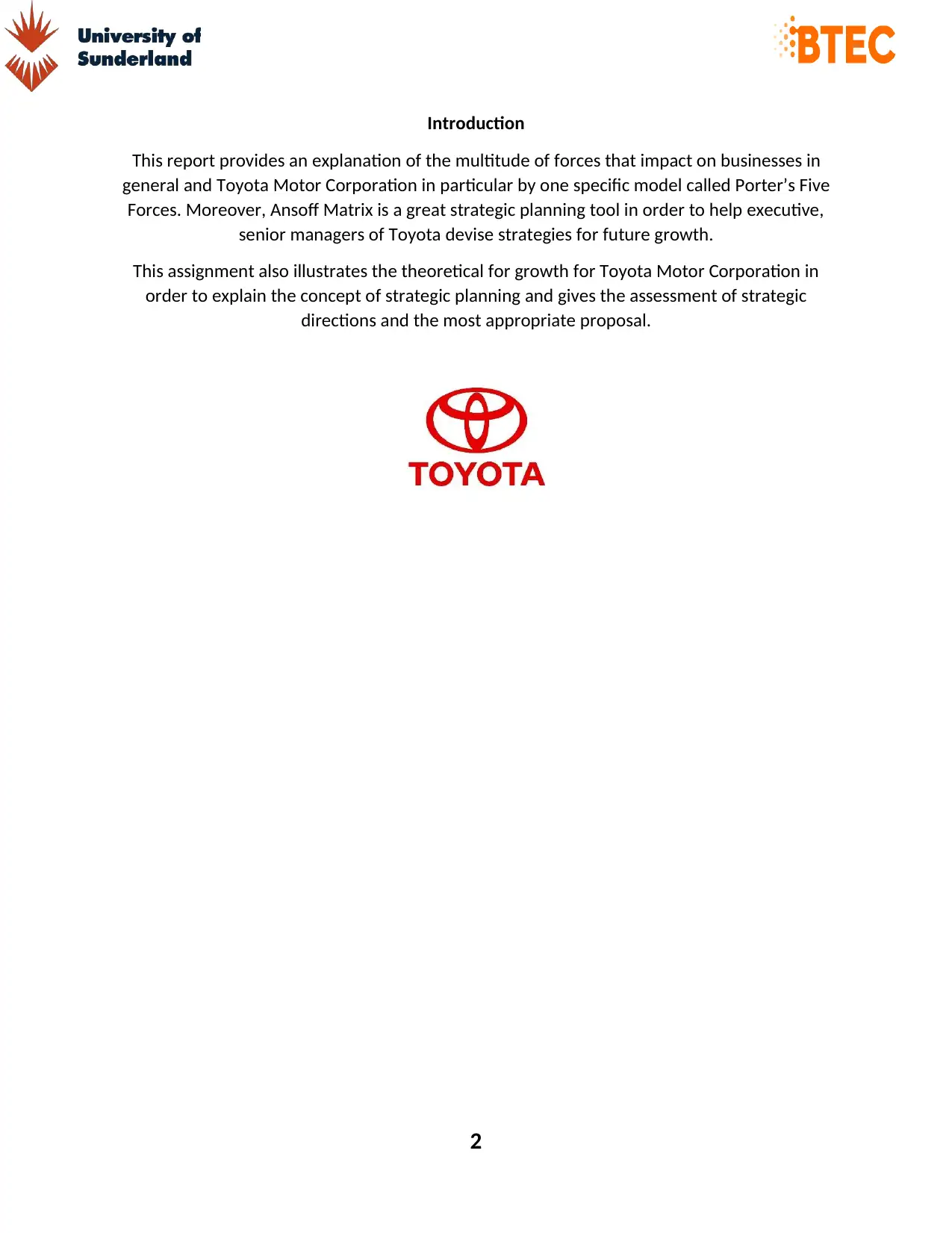
2
Introduction
This report provides an explanation of the multitude of forces that impact on businesses in
general and Toyota Motor Corporation in particular by one specific model called Porter’s Five
Forces. Moreover, Ansoff Matrix is a great strategic planning tool in order to help executive,
senior managers of Toyota devise strategies for future growth.
This assignment also illustrates the theoretical for growth for Toyota Motor Corporation in
order to explain the concept of strategic planning and gives the assessment of strategic
directions and the most appropriate proposal.
Introduction
This report provides an explanation of the multitude of forces that impact on businesses in
general and Toyota Motor Corporation in particular by one specific model called Porter’s Five
Forces. Moreover, Ansoff Matrix is a great strategic planning tool in order to help executive,
senior managers of Toyota devise strategies for future growth.
This assignment also illustrates the theoretical for growth for Toyota Motor Corporation in
order to explain the concept of strategic planning and gives the assessment of strategic
directions and the most appropriate proposal.
⊘ This is a preview!⊘
Do you want full access?
Subscribe today to unlock all pages.

Trusted by 1+ million students worldwide
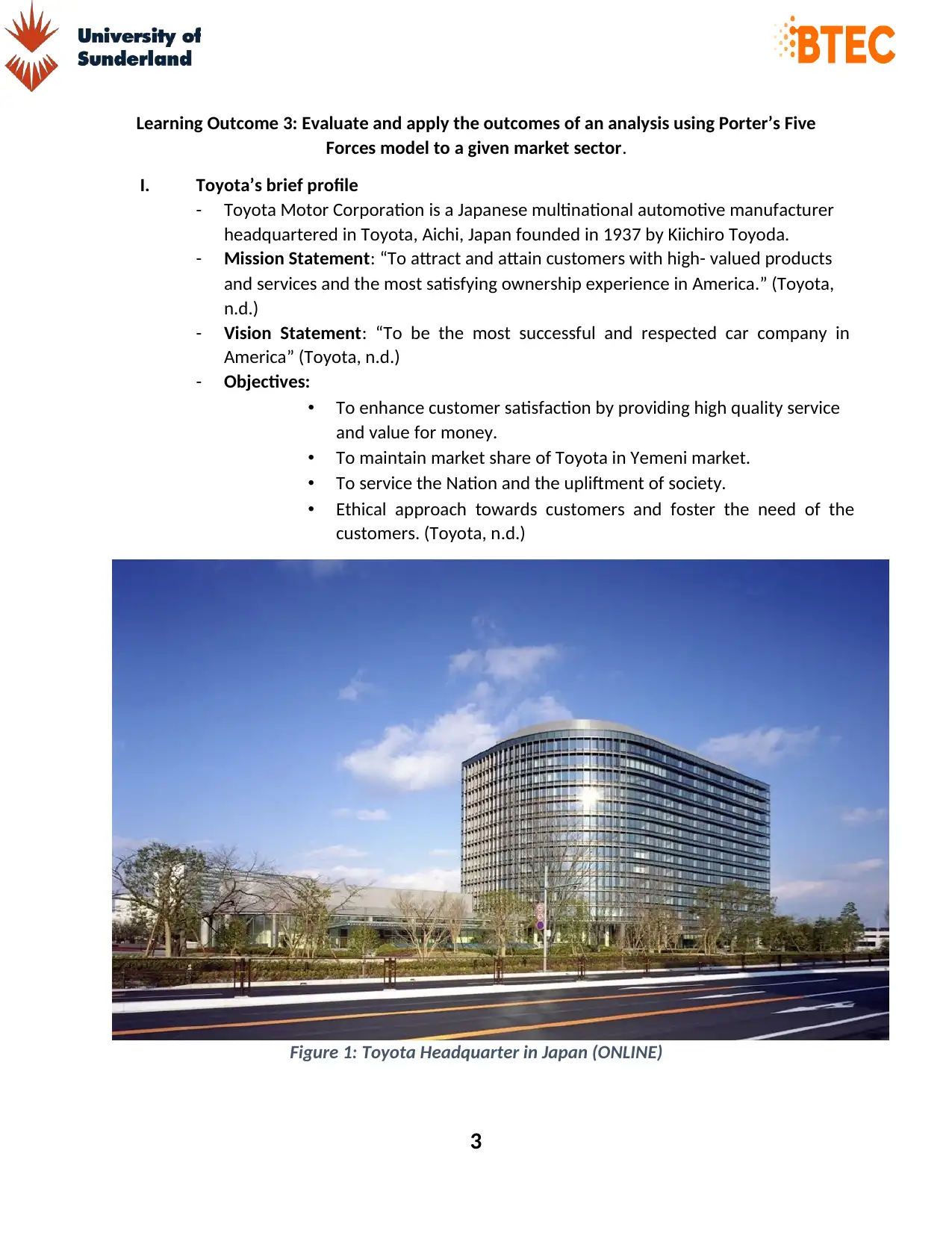
3
Learning Outcome 3: Evaluate and apply the outcomes of an analysis using Porter’s Five
Forces model to a given market sector.
I. Toyota’s brief profile
- Toyota Motor Corporation is a Japanese multinational automotive manufacturer
headquartered in Toyota, Aichi, Japan founded in 1937 by Kiichiro Toyoda.
- Mission Statement: “To attract and attain customers with high- valued products
and services and the most satisfying ownership experience in America.” (Toyota,
n.d.)
- Vision Statement: “To be the most successful and respected car company in
America” (Toyota, n.d.)
- Objectives:
• To enhance customer satisfaction by providing high quality service
and value for money.
• To maintain market share of Toyota in Yemeni market.
• To service the Nation and the upliftment of society.
• Ethical approach towards customers and foster the need of the
customers. (Toyota, n.d.)
Figure 1: Toyota Headquarter in Japan (ONLINE)
Learning Outcome 3: Evaluate and apply the outcomes of an analysis using Porter’s Five
Forces model to a given market sector.
I. Toyota’s brief profile
- Toyota Motor Corporation is a Japanese multinational automotive manufacturer
headquartered in Toyota, Aichi, Japan founded in 1937 by Kiichiro Toyoda.
- Mission Statement: “To attract and attain customers with high- valued products
and services and the most satisfying ownership experience in America.” (Toyota,
n.d.)
- Vision Statement: “To be the most successful and respected car company in
America” (Toyota, n.d.)
- Objectives:
• To enhance customer satisfaction by providing high quality service
and value for money.
• To maintain market share of Toyota in Yemeni market.
• To service the Nation and the upliftment of society.
• Ethical approach towards customers and foster the need of the
customers. (Toyota, n.d.)
Figure 1: Toyota Headquarter in Japan (ONLINE)
Paraphrase This Document
Need a fresh take? Get an instant paraphrase of this document with our AI Paraphraser
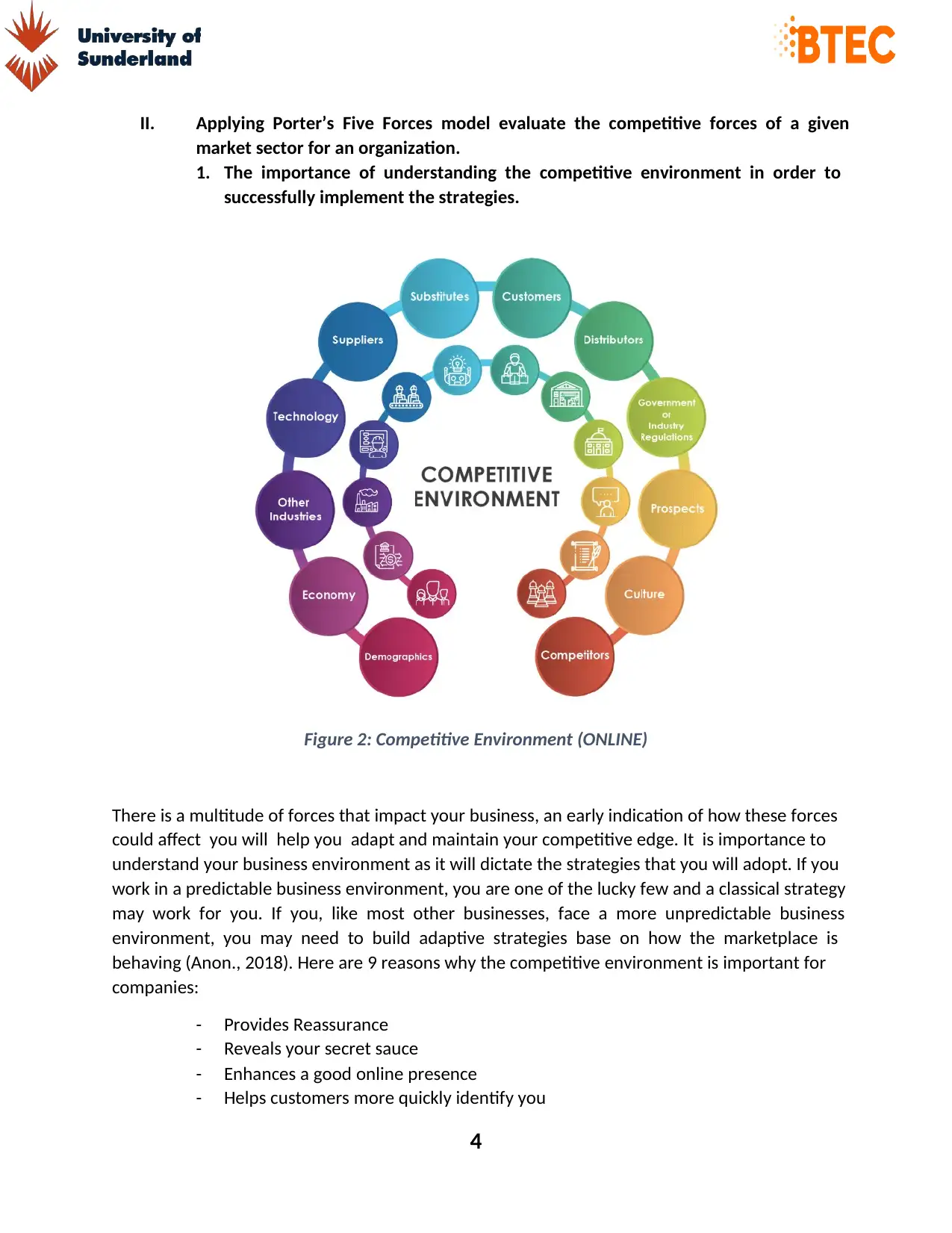
4
II. Applying Porter’s Five Forces model evaluate the competitive forces of a given
market sector for an organization.
1. The importance of understanding the competitive environment in order to
successfully implement the strategies.
Figure 2: Competitive Environment (ONLINE)
There is a multitude of forces that impact your business, an early indication of how these forces
could affect you will help you adapt and maintain your competitive edge. It is importance to
understand your business environment as it will dictate the strategies that you will adopt. If you
work in a predictable business environment, you are one of the lucky few and a classical strategy
may work for you. If you, like most other businesses, face a more unpredictable business
environment, you may need to build adaptive strategies base on how the marketplace is
behaving (Anon., 2018). Here are 9 reasons why the competitive environment is important for
companies:
- Provides Reassurance
- Reveals your secret sauce
- Enhances a good online presence
- Helps customers more quickly identify you
II. Applying Porter’s Five Forces model evaluate the competitive forces of a given
market sector for an organization.
1. The importance of understanding the competitive environment in order to
successfully implement the strategies.
Figure 2: Competitive Environment (ONLINE)
There is a multitude of forces that impact your business, an early indication of how these forces
could affect you will help you adapt and maintain your competitive edge. It is importance to
understand your business environment as it will dictate the strategies that you will adopt. If you
work in a predictable business environment, you are one of the lucky few and a classical strategy
may work for you. If you, like most other businesses, face a more unpredictable business
environment, you may need to build adaptive strategies base on how the marketplace is
behaving (Anon., 2018). Here are 9 reasons why the competitive environment is important for
companies:
- Provides Reassurance
- Reveals your secret sauce
- Enhances a good online presence
- Helps customers more quickly identify you
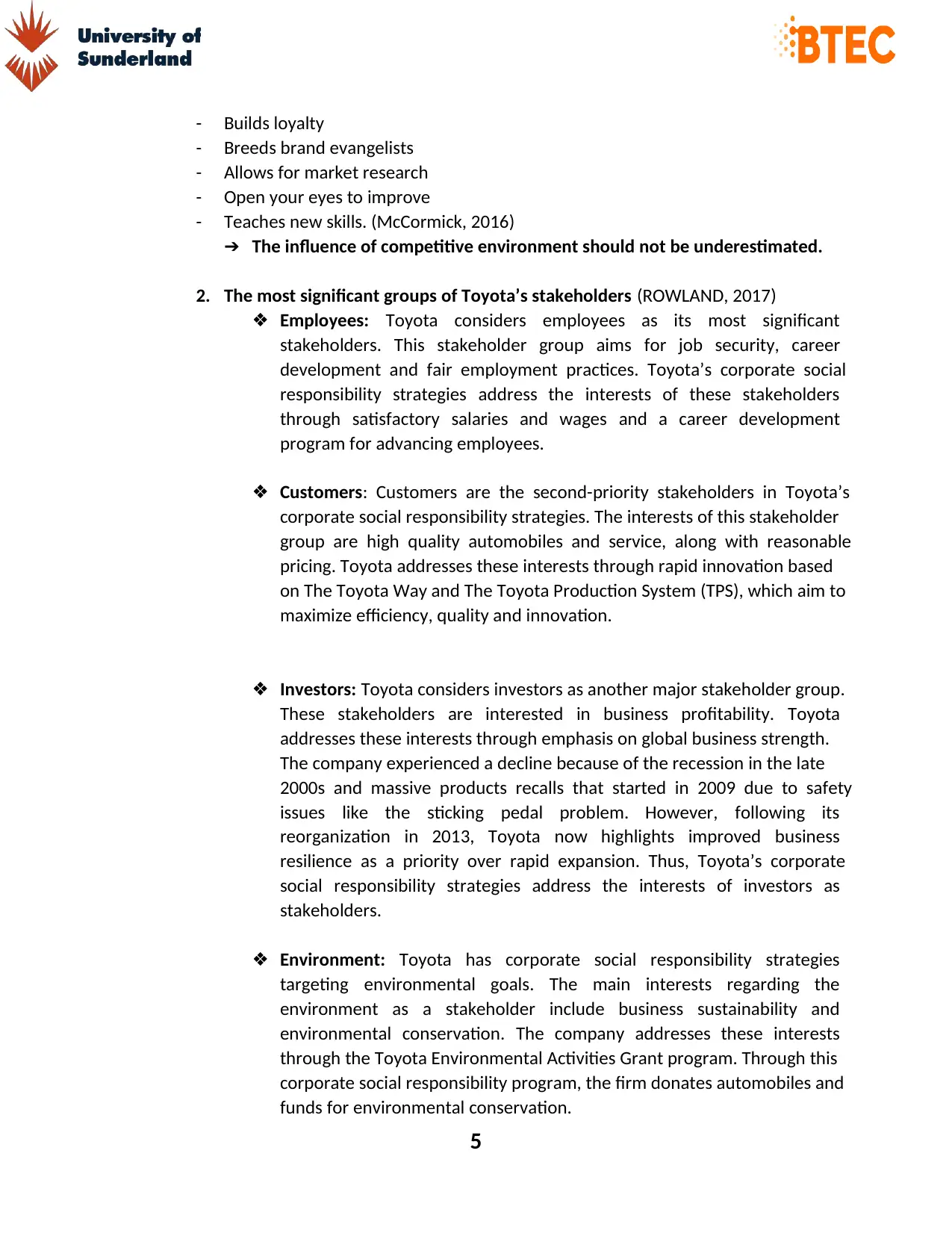
5
- Builds loyalty
- Breeds brand evangelists
- Allows for market research
- Open your eyes to improve
- Teaches new skills. (McCormick, 2016)
➔ The influence of competitive environment should not be underestimated.
2. The most significant groups of Toyota’s stakeholders (ROWLAND, 2017)
❖ Employees: Toyota considers employees as its most significant
stakeholders. This stakeholder group aims for job security, career
development and fair employment practices. Toyota’s corporate social
responsibility strategies address the interests of these stakeholders
through satisfactory salaries and wages and a career development
program for advancing employees.
❖ Customers: Customers are the second-priority stakeholders in Toyota’s
corporate social responsibility strategies. The interests of this stakeholder
group are high quality automobiles and service, along with reasonable
pricing. Toyota addresses these interests through rapid innovation based
on The Toyota Way and The Toyota Production System (TPS), which aim to
maximize efficiency, quality and innovation.
❖ Investors: Toyota considers investors as another major stakeholder group.
These stakeholders are interested in business profitability. Toyota
addresses these interests through emphasis on global business strength.
The company experienced a decline because of the recession in the late
2000s and massive products recalls that started in 2009 due to safety
issues like the sticking pedal problem. However, following its
reorganization in 2013, Toyota now highlights improved business
resilience as a priority over rapid expansion. Thus, Toyota’s corporate
social responsibility strategies address the interests of investors as
stakeholders.
❖ Environment: Toyota has corporate social responsibility strategies
targeting environmental goals. The main interests regarding the
environment as a stakeholder include business sustainability and
environmental conservation. The company addresses these interests
through the Toyota Environmental Activities Grant program. Through this
corporate social responsibility program, the firm donates automobiles and
funds for environmental conservation.
- Builds loyalty
- Breeds brand evangelists
- Allows for market research
- Open your eyes to improve
- Teaches new skills. (McCormick, 2016)
➔ The influence of competitive environment should not be underestimated.
2. The most significant groups of Toyota’s stakeholders (ROWLAND, 2017)
❖ Employees: Toyota considers employees as its most significant
stakeholders. This stakeholder group aims for job security, career
development and fair employment practices. Toyota’s corporate social
responsibility strategies address the interests of these stakeholders
through satisfactory salaries and wages and a career development
program for advancing employees.
❖ Customers: Customers are the second-priority stakeholders in Toyota’s
corporate social responsibility strategies. The interests of this stakeholder
group are high quality automobiles and service, along with reasonable
pricing. Toyota addresses these interests through rapid innovation based
on The Toyota Way and The Toyota Production System (TPS), which aim to
maximize efficiency, quality and innovation.
❖ Investors: Toyota considers investors as another major stakeholder group.
These stakeholders are interested in business profitability. Toyota
addresses these interests through emphasis on global business strength.
The company experienced a decline because of the recession in the late
2000s and massive products recalls that started in 2009 due to safety
issues like the sticking pedal problem. However, following its
reorganization in 2013, Toyota now highlights improved business
resilience as a priority over rapid expansion. Thus, Toyota’s corporate
social responsibility strategies address the interests of investors as
stakeholders.
❖ Environment: Toyota has corporate social responsibility strategies
targeting environmental goals. The main interests regarding the
environment as a stakeholder include business sustainability and
environmental conservation. The company addresses these interests
through the Toyota Environmental Activities Grant program. Through this
corporate social responsibility program, the firm donates automobiles and
funds for environmental conservation.
⊘ This is a preview!⊘
Do you want full access?
Subscribe today to unlock all pages.

Trusted by 1+ million students worldwide
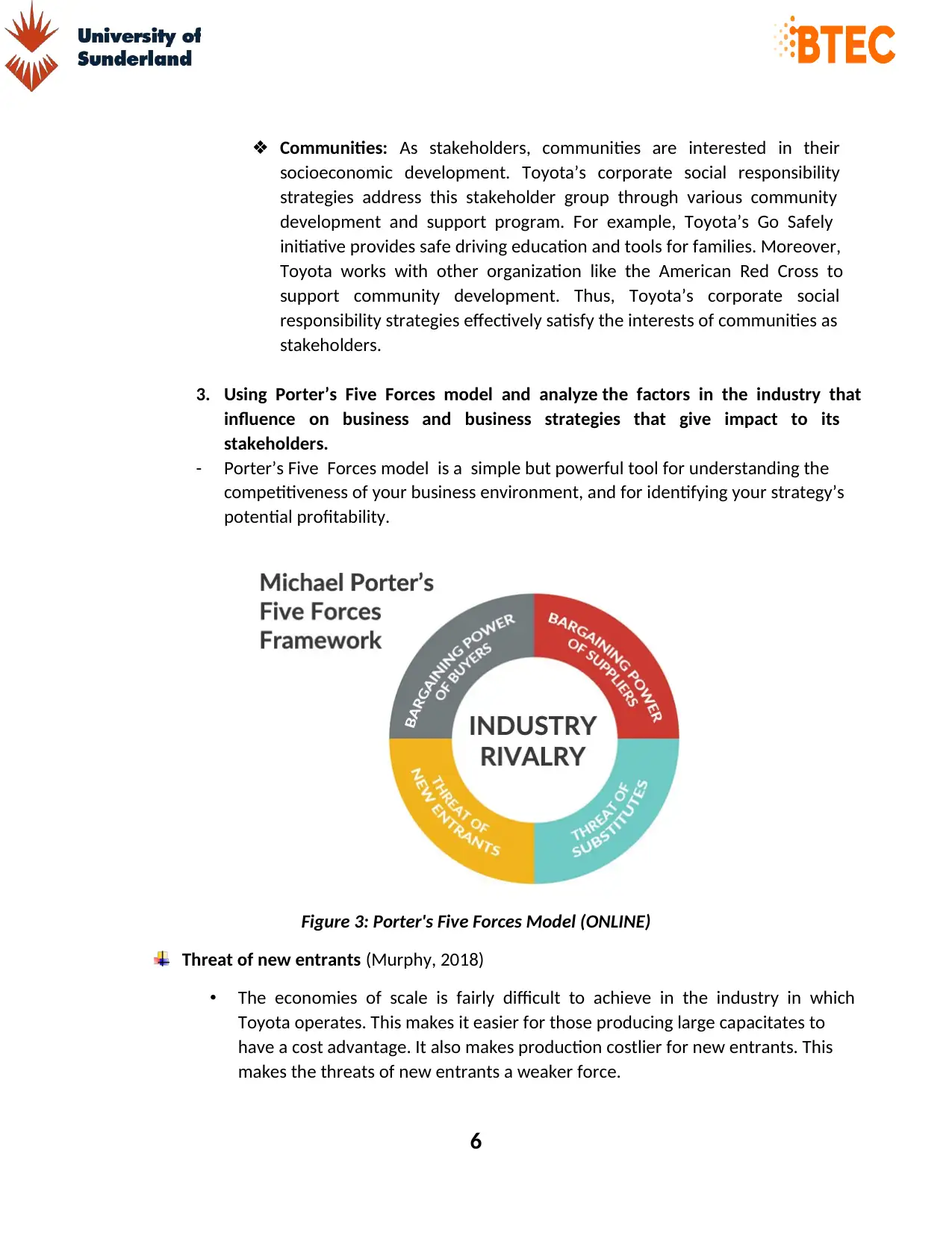
6
❖ Communities: As stakeholders, communities are interested in their
socioeconomic development. Toyota’s corporate social responsibility
strategies address this stakeholder group through various community
development and support program. For example, Toyota’s Go Safely
initiative provides safe driving education and tools for families. Moreover,
Toyota works with other organization like the American Red Cross to
support community development. Thus, Toyota’s corporate social
responsibility strategies effectively satisfy the interests of communities as
stakeholders.
3. Using Porter’s Five Forces model and analyze the factors in the industry that
influence on business and business strategies that give impact to its
stakeholders.
- Porter’s Five Forces model is a simple but powerful tool for understanding the
competitiveness of your business environment, and for identifying your strategy’s
potential profitability.
Figure 3: Porter's Five Forces Model (ONLINE)
Threat of new entrants (Murphy, 2018)
• The economies of scale is fairly difficult to achieve in the industry in which
Toyota operates. This makes it easier for those producing large capacitates to
have a cost advantage. It also makes production costlier for new entrants. This
makes the threats of new entrants a weaker force.
❖ Communities: As stakeholders, communities are interested in their
socioeconomic development. Toyota’s corporate social responsibility
strategies address this stakeholder group through various community
development and support program. For example, Toyota’s Go Safely
initiative provides safe driving education and tools for families. Moreover,
Toyota works with other organization like the American Red Cross to
support community development. Thus, Toyota’s corporate social
responsibility strategies effectively satisfy the interests of communities as
stakeholders.
3. Using Porter’s Five Forces model and analyze the factors in the industry that
influence on business and business strategies that give impact to its
stakeholders.
- Porter’s Five Forces model is a simple but powerful tool for understanding the
competitiveness of your business environment, and for identifying your strategy’s
potential profitability.
Figure 3: Porter's Five Forces Model (ONLINE)
Threat of new entrants (Murphy, 2018)
• The economies of scale is fairly difficult to achieve in the industry in which
Toyota operates. This makes it easier for those producing large capacitates to
have a cost advantage. It also makes production costlier for new entrants. This
makes the threats of new entrants a weaker force.
Paraphrase This Document
Need a fresh take? Get an instant paraphrase of this document with our AI Paraphraser
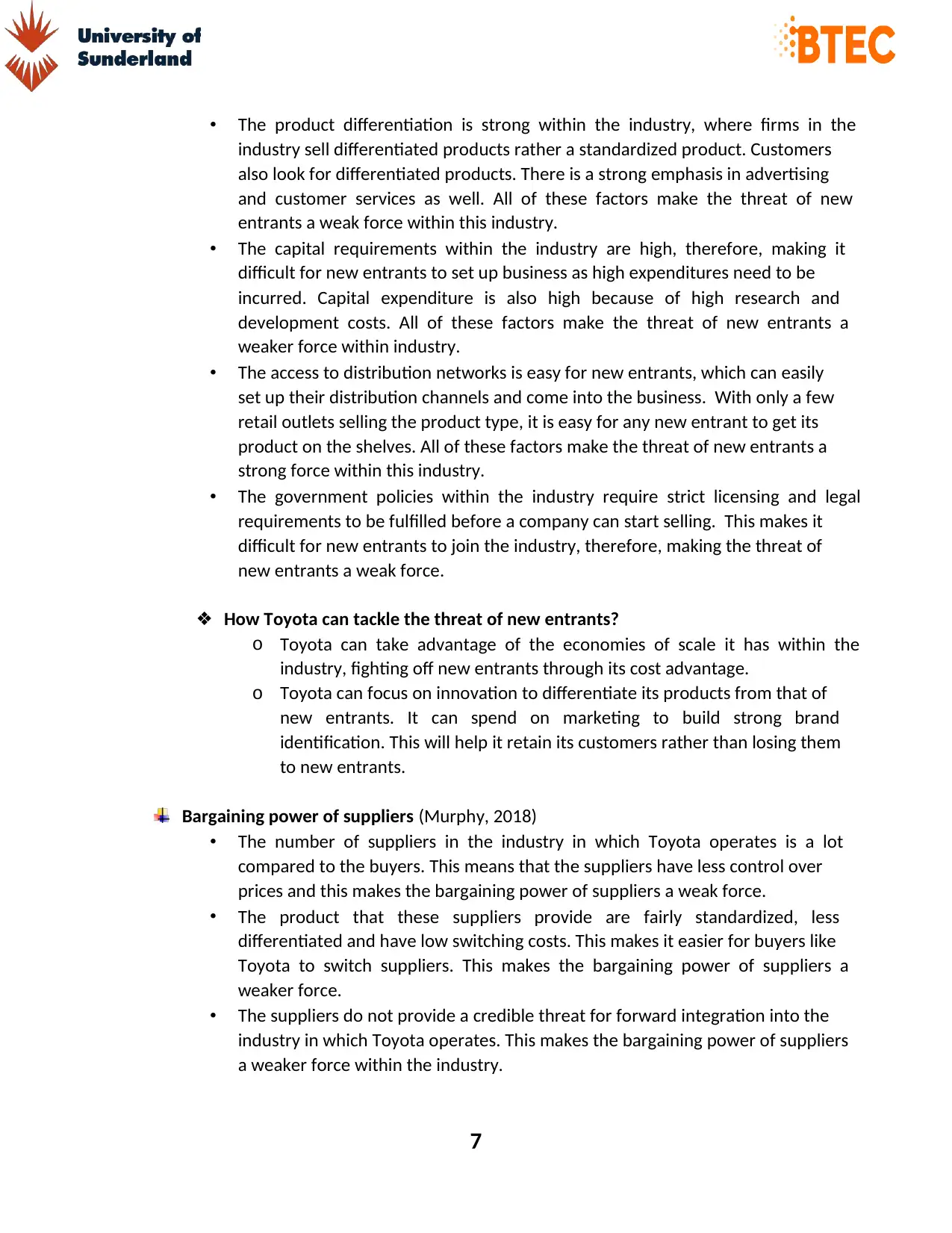
7
• The product differentiation is strong within the industry, where firms in the
industry sell differentiated products rather a standardized product. Customers
also look for differentiated products. There is a strong emphasis in advertising
and customer services as well. All of these factors make the threat of new
entrants a weak force within this industry.
• The capital requirements within the industry are high, therefore, making it
difficult for new entrants to set up business as high expenditures need to be
incurred. Capital expenditure is also high because of high research and
development costs. All of these factors make the threat of new entrants a
weaker force within industry.
• The access to distribution networks is easy for new entrants, which can easily
set up their distribution channels and come into the business. With only a few
retail outlets selling the product type, it is easy for any new entrant to get its
product on the shelves. All of these factors make the threat of new entrants a
strong force within this industry.
• The government policies within the industry require strict licensing and legal
requirements to be fulfilled before a company can start selling. This makes it
difficult for new entrants to join the industry, therefore, making the threat of
new entrants a weak force.
❖ How Toyota can tackle the threat of new entrants?
o Toyota can take advantage of the economies of scale it has within the
industry, fighting off new entrants through its cost advantage.
o Toyota can focus on innovation to differentiate its products from that of
new entrants. It can spend on marketing to build strong brand
identification. This will help it retain its customers rather than losing them
to new entrants.
Bargaining power of suppliers (Murphy, 2018)
• The number of suppliers in the industry in which Toyota operates is a lot
compared to the buyers. This means that the suppliers have less control over
prices and this makes the bargaining power of suppliers a weak force.
• The product that these suppliers provide are fairly standardized, less
differentiated and have low switching costs. This makes it easier for buyers like
Toyota to switch suppliers. This makes the bargaining power of suppliers a
weaker force.
• The suppliers do not provide a credible threat for forward integration into the
industry in which Toyota operates. This makes the bargaining power of suppliers
a weaker force within the industry.
• The product differentiation is strong within the industry, where firms in the
industry sell differentiated products rather a standardized product. Customers
also look for differentiated products. There is a strong emphasis in advertising
and customer services as well. All of these factors make the threat of new
entrants a weak force within this industry.
• The capital requirements within the industry are high, therefore, making it
difficult for new entrants to set up business as high expenditures need to be
incurred. Capital expenditure is also high because of high research and
development costs. All of these factors make the threat of new entrants a
weaker force within industry.
• The access to distribution networks is easy for new entrants, which can easily
set up their distribution channels and come into the business. With only a few
retail outlets selling the product type, it is easy for any new entrant to get its
product on the shelves. All of these factors make the threat of new entrants a
strong force within this industry.
• The government policies within the industry require strict licensing and legal
requirements to be fulfilled before a company can start selling. This makes it
difficult for new entrants to join the industry, therefore, making the threat of
new entrants a weak force.
❖ How Toyota can tackle the threat of new entrants?
o Toyota can take advantage of the economies of scale it has within the
industry, fighting off new entrants through its cost advantage.
o Toyota can focus on innovation to differentiate its products from that of
new entrants. It can spend on marketing to build strong brand
identification. This will help it retain its customers rather than losing them
to new entrants.
Bargaining power of suppliers (Murphy, 2018)
• The number of suppliers in the industry in which Toyota operates is a lot
compared to the buyers. This means that the suppliers have less control over
prices and this makes the bargaining power of suppliers a weak force.
• The product that these suppliers provide are fairly standardized, less
differentiated and have low switching costs. This makes it easier for buyers like
Toyota to switch suppliers. This makes the bargaining power of suppliers a
weaker force.
• The suppliers do not provide a credible threat for forward integration into the
industry in which Toyota operates. This makes the bargaining power of suppliers
a weaker force within the industry.
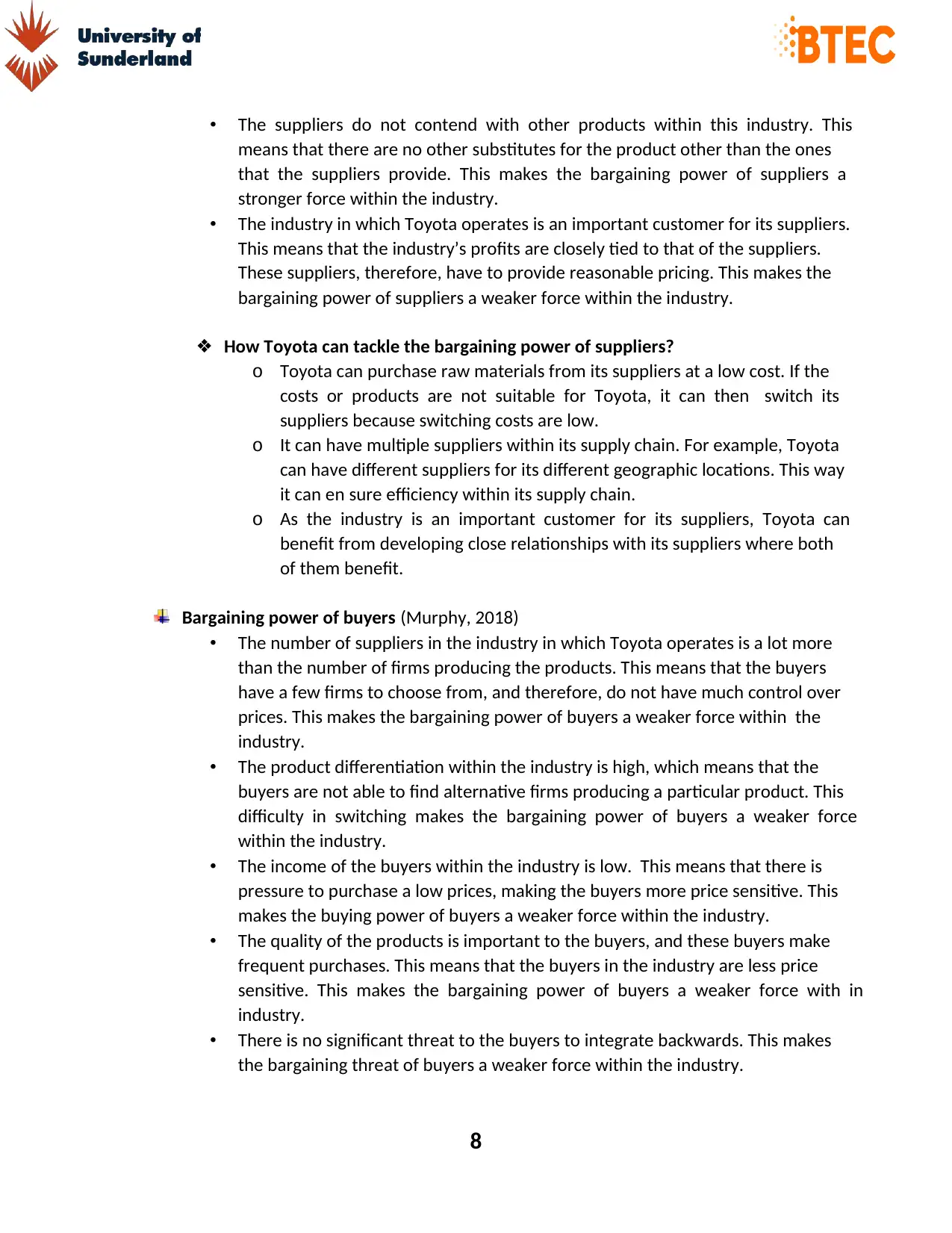
8
• The suppliers do not contend with other products within this industry. This
means that there are no other substitutes for the product other than the ones
that the suppliers provide. This makes the bargaining power of suppliers a
stronger force within the industry.
• The industry in which Toyota operates is an important customer for its suppliers.
This means that the industry’s profits are closely tied to that of the suppliers.
These suppliers, therefore, have to provide reasonable pricing. This makes the
bargaining power of suppliers a weaker force within the industry.
❖ How Toyota can tackle the bargaining power of suppliers?
o Toyota can purchase raw materials from its suppliers at a low cost. If the
costs or products are not suitable for Toyota, it can then switch its
suppliers because switching costs are low.
o It can have multiple suppliers within its supply chain. For example, Toyota
can have different suppliers for its different geographic locations. This way
it can en sure efficiency within its supply chain.
o As the industry is an important customer for its suppliers, Toyota can
benefit from developing close relationships with its suppliers where both
of them benefit.
Bargaining power of buyers (Murphy, 2018)
• The number of suppliers in the industry in which Toyota operates is a lot more
than the number of firms producing the products. This means that the buyers
have a few firms to choose from, and therefore, do not have much control over
prices. This makes the bargaining power of buyers a weaker force within the
industry.
• The product differentiation within the industry is high, which means that the
buyers are not able to find alternative firms producing a particular product. This
difficulty in switching makes the bargaining power of buyers a weaker force
within the industry.
• The income of the buyers within the industry is low. This means that there is
pressure to purchase a low prices, making the buyers more price sensitive. This
makes the buying power of buyers a weaker force within the industry.
• The quality of the products is important to the buyers, and these buyers make
frequent purchases. This means that the buyers in the industry are less price
sensitive. This makes the bargaining power of buyers a weaker force with in
industry.
• There is no significant threat to the buyers to integrate backwards. This makes
the bargaining threat of buyers a weaker force within the industry.
• The suppliers do not contend with other products within this industry. This
means that there are no other substitutes for the product other than the ones
that the suppliers provide. This makes the bargaining power of suppliers a
stronger force within the industry.
• The industry in which Toyota operates is an important customer for its suppliers.
This means that the industry’s profits are closely tied to that of the suppliers.
These suppliers, therefore, have to provide reasonable pricing. This makes the
bargaining power of suppliers a weaker force within the industry.
❖ How Toyota can tackle the bargaining power of suppliers?
o Toyota can purchase raw materials from its suppliers at a low cost. If the
costs or products are not suitable for Toyota, it can then switch its
suppliers because switching costs are low.
o It can have multiple suppliers within its supply chain. For example, Toyota
can have different suppliers for its different geographic locations. This way
it can en sure efficiency within its supply chain.
o As the industry is an important customer for its suppliers, Toyota can
benefit from developing close relationships with its suppliers where both
of them benefit.
Bargaining power of buyers (Murphy, 2018)
• The number of suppliers in the industry in which Toyota operates is a lot more
than the number of firms producing the products. This means that the buyers
have a few firms to choose from, and therefore, do not have much control over
prices. This makes the bargaining power of buyers a weaker force within the
industry.
• The product differentiation within the industry is high, which means that the
buyers are not able to find alternative firms producing a particular product. This
difficulty in switching makes the bargaining power of buyers a weaker force
within the industry.
• The income of the buyers within the industry is low. This means that there is
pressure to purchase a low prices, making the buyers more price sensitive. This
makes the buying power of buyers a weaker force within the industry.
• The quality of the products is important to the buyers, and these buyers make
frequent purchases. This means that the buyers in the industry are less price
sensitive. This makes the bargaining power of buyers a weaker force with in
industry.
• There is no significant threat to the buyers to integrate backwards. This makes
the bargaining threat of buyers a weaker force within the industry.
⊘ This is a preview!⊘
Do you want full access?
Subscribe today to unlock all pages.

Trusted by 1+ million students worldwide
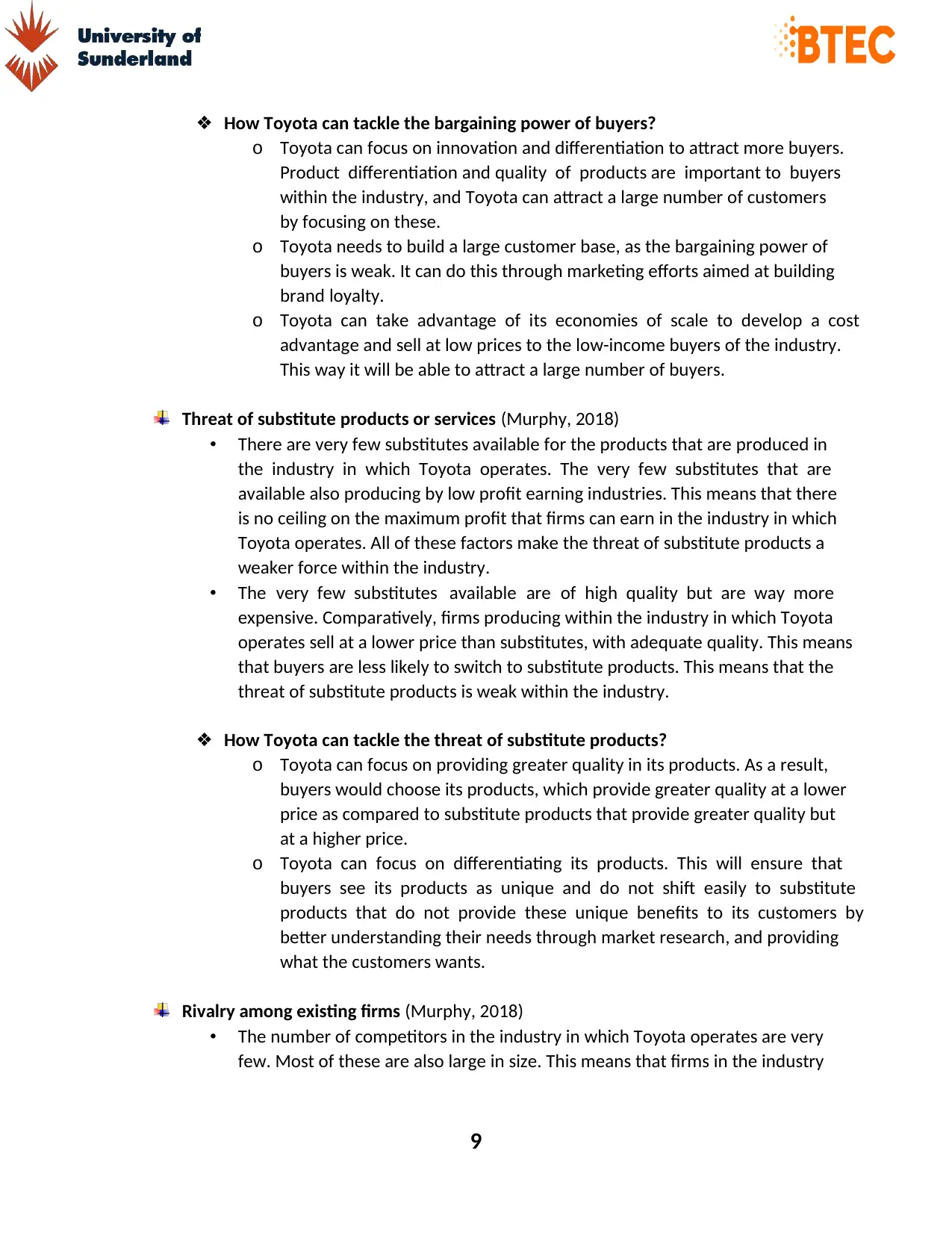
9
❖ How Toyota can tackle the bargaining power of buyers?
o Toyota can focus on innovation and differentiation to attract more buyers.
Product differentiation and quality of products are important to buyers
within the industry, and Toyota can attract a large number of customers
by focusing on these.
o Toyota needs to build a large customer base, as the bargaining power of
buyers is weak. It can do this through marketing efforts aimed at building
brand loyalty.
o Toyota can take advantage of its economies of scale to develop a cost
advantage and sell at low prices to the low-income buyers of the industry.
This way it will be able to attract a large number of buyers.
Threat of substitute products or services (Murphy, 2018)
• There are very few substitutes available for the products that are produced in
the industry in which Toyota operates. The very few substitutes that are
available also producing by low profit earning industries. This means that there
is no ceiling on the maximum profit that firms can earn in the industry in which
Toyota operates. All of these factors make the threat of substitute products a
weaker force within the industry.
• The very few substitutes available are of high quality but are way more
expensive. Comparatively, firms producing within the industry in which Toyota
operates sell at a lower price than substitutes, with adequate quality. This means
that buyers are less likely to switch to substitute products. This means that the
threat of substitute products is weak within the industry.
❖ How Toyota can tackle the threat of substitute products?
o Toyota can focus on providing greater quality in its products. As a result,
buyers would choose its products, which provide greater quality at a lower
price as compared to substitute products that provide greater quality but
at a higher price.
o Toyota can focus on differentiating its products. This will ensure that
buyers see its products as unique and do not shift easily to substitute
products that do not provide these unique benefits to its customers by
better understanding their needs through market research, and providing
what the customers wants.
Rivalry among existing firms (Murphy, 2018)
• The number of competitors in the industry in which Toyota operates are very
few. Most of these are also large in size. This means that firms in the industry
❖ How Toyota can tackle the bargaining power of buyers?
o Toyota can focus on innovation and differentiation to attract more buyers.
Product differentiation and quality of products are important to buyers
within the industry, and Toyota can attract a large number of customers
by focusing on these.
o Toyota needs to build a large customer base, as the bargaining power of
buyers is weak. It can do this through marketing efforts aimed at building
brand loyalty.
o Toyota can take advantage of its economies of scale to develop a cost
advantage and sell at low prices to the low-income buyers of the industry.
This way it will be able to attract a large number of buyers.
Threat of substitute products or services (Murphy, 2018)
• There are very few substitutes available for the products that are produced in
the industry in which Toyota operates. The very few substitutes that are
available also producing by low profit earning industries. This means that there
is no ceiling on the maximum profit that firms can earn in the industry in which
Toyota operates. All of these factors make the threat of substitute products a
weaker force within the industry.
• The very few substitutes available are of high quality but are way more
expensive. Comparatively, firms producing within the industry in which Toyota
operates sell at a lower price than substitutes, with adequate quality. This means
that buyers are less likely to switch to substitute products. This means that the
threat of substitute products is weak within the industry.
❖ How Toyota can tackle the threat of substitute products?
o Toyota can focus on providing greater quality in its products. As a result,
buyers would choose its products, which provide greater quality at a lower
price as compared to substitute products that provide greater quality but
at a higher price.
o Toyota can focus on differentiating its products. This will ensure that
buyers see its products as unique and do not shift easily to substitute
products that do not provide these unique benefits to its customers by
better understanding their needs through market research, and providing
what the customers wants.
Rivalry among existing firms (Murphy, 2018)
• The number of competitors in the industry in which Toyota operates are very
few. Most of these are also large in size. This means that firms in the industry
Paraphrase This Document
Need a fresh take? Get an instant paraphrase of this document with our AI Paraphraser
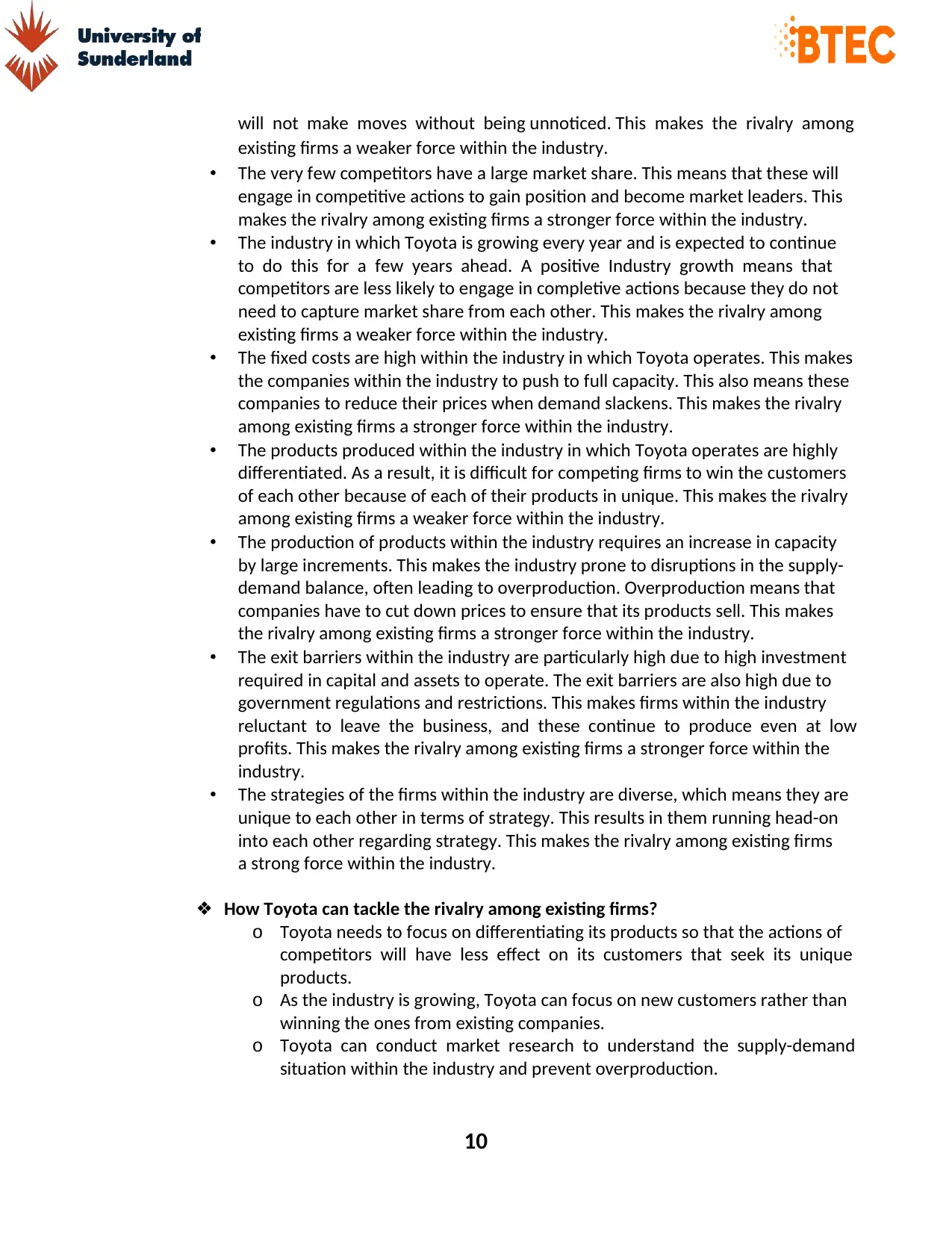
10
will not make moves without being unnoticed. This makes the rivalry among
existing firms a weaker force within the industry.
• The very few competitors have a large market share. This means that these will
engage in competitive actions to gain position and become market leaders. This
makes the rivalry among existing firms a stronger force within the industry.
• The industry in which Toyota is growing every year and is expected to continue
to do this for a few years ahead. A positive Industry growth means that
competitors are less likely to engage in completive actions because they do not
need to capture market share from each other. This makes the rivalry among
existing firms a weaker force within the industry.
• The fixed costs are high within the industry in which Toyota operates. This makes
the companies within the industry to push to full capacity. This also means these
companies to reduce their prices when demand slackens. This makes the rivalry
among existing firms a stronger force within the industry.
• The products produced within the industry in which Toyota operates are highly
differentiated. As a result, it is difficult for competing firms to win the customers
of each other because of each of their products in unique. This makes the rivalry
among existing firms a weaker force within the industry.
• The production of products within the industry requires an increase in capacity
by large increments. This makes the industry prone to disruptions in the supply-
demand balance, often leading to overproduction. Overproduction means that
companies have to cut down prices to ensure that its products sell. This makes
the rivalry among existing firms a stronger force within the industry.
• The exit barriers within the industry are particularly high due to high investment
required in capital and assets to operate. The exit barriers are also high due to
government regulations and restrictions. This makes firms within the industry
reluctant to leave the business, and these continue to produce even at low
profits. This makes the rivalry among existing firms a stronger force within the
industry.
• The strategies of the firms within the industry are diverse, which means they are
unique to each other in terms of strategy. This results in them running head-on
into each other regarding strategy. This makes the rivalry among existing firms
a strong force within the industry.
❖ How Toyota can tackle the rivalry among existing firms?
o Toyota needs to focus on differentiating its products so that the actions of
competitors will have less effect on its customers that seek its unique
products.
o As the industry is growing, Toyota can focus on new customers rather than
winning the ones from existing companies.
o Toyota can conduct market research to understand the supply-demand
situation within the industry and prevent overproduction.
will not make moves without being unnoticed. This makes the rivalry among
existing firms a weaker force within the industry.
• The very few competitors have a large market share. This means that these will
engage in competitive actions to gain position and become market leaders. This
makes the rivalry among existing firms a stronger force within the industry.
• The industry in which Toyota is growing every year and is expected to continue
to do this for a few years ahead. A positive Industry growth means that
competitors are less likely to engage in completive actions because they do not
need to capture market share from each other. This makes the rivalry among
existing firms a weaker force within the industry.
• The fixed costs are high within the industry in which Toyota operates. This makes
the companies within the industry to push to full capacity. This also means these
companies to reduce their prices when demand slackens. This makes the rivalry
among existing firms a stronger force within the industry.
• The products produced within the industry in which Toyota operates are highly
differentiated. As a result, it is difficult for competing firms to win the customers
of each other because of each of their products in unique. This makes the rivalry
among existing firms a weaker force within the industry.
• The production of products within the industry requires an increase in capacity
by large increments. This makes the industry prone to disruptions in the supply-
demand balance, often leading to overproduction. Overproduction means that
companies have to cut down prices to ensure that its products sell. This makes
the rivalry among existing firms a stronger force within the industry.
• The exit barriers within the industry are particularly high due to high investment
required in capital and assets to operate. The exit barriers are also high due to
government regulations and restrictions. This makes firms within the industry
reluctant to leave the business, and these continue to produce even at low
profits. This makes the rivalry among existing firms a stronger force within the
industry.
• The strategies of the firms within the industry are diverse, which means they are
unique to each other in terms of strategy. This results in them running head-on
into each other regarding strategy. This makes the rivalry among existing firms
a strong force within the industry.
❖ How Toyota can tackle the rivalry among existing firms?
o Toyota needs to focus on differentiating its products so that the actions of
competitors will have less effect on its customers that seek its unique
products.
o As the industry is growing, Toyota can focus on new customers rather than
winning the ones from existing companies.
o Toyota can conduct market research to understand the supply-demand
situation within the industry and prevent overproduction.
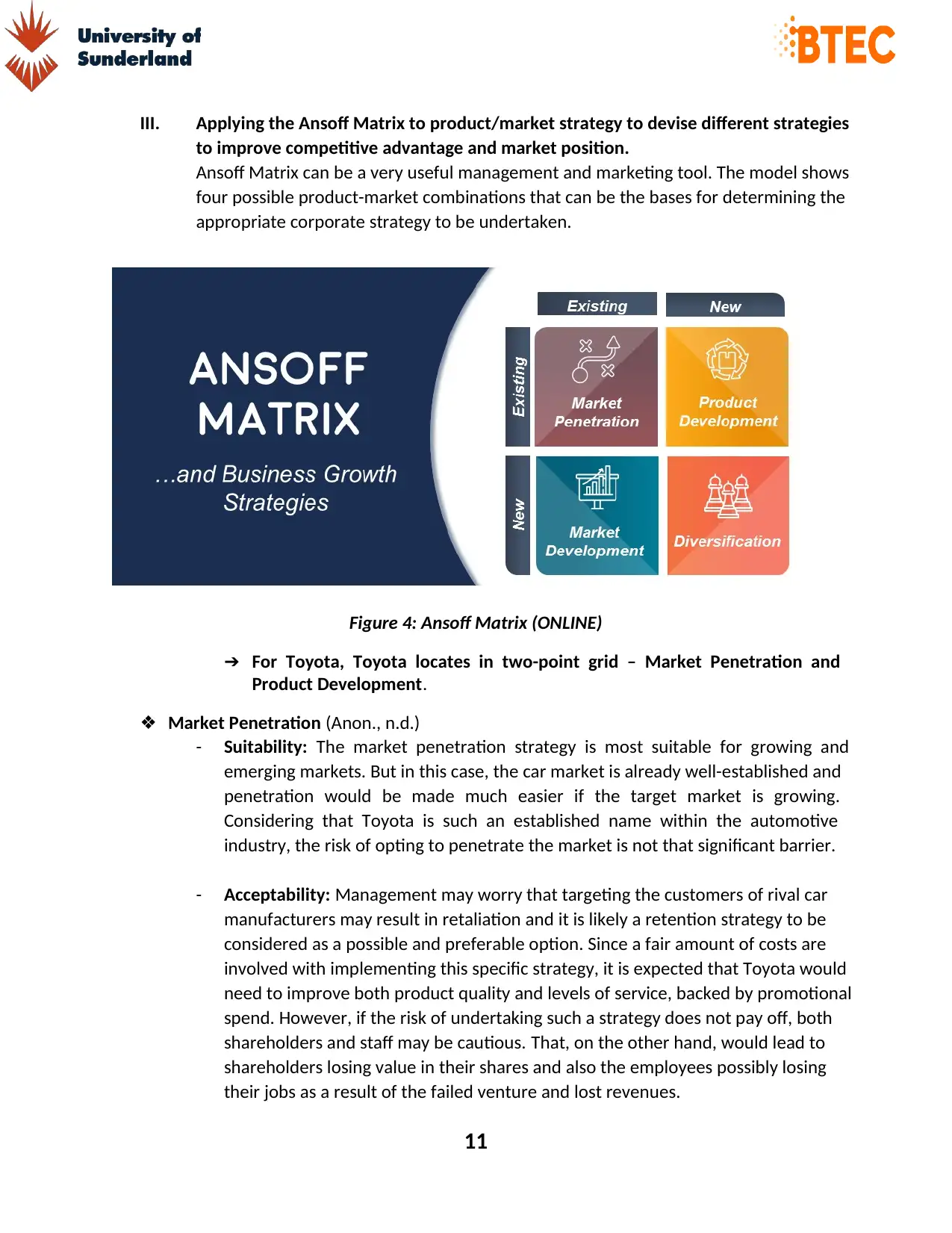
11
III. Applying the Ansoff Matrix to product/market strategy to devise different strategies
to improve competitive advantage and market position.
Ansoff Matrix can be a very useful management and marketing tool. The model shows
four possible product-market combinations that can be the bases for determining the
appropriate corporate strategy to be undertaken.
Figure 4: Ansoff Matrix (ONLINE)
➔ For Toyota, Toyota locates in two-point grid – Market Penetration and
Product Development.
❖ Market Penetration (Anon., n.d.)
- Suitability: The market penetration strategy is most suitable for growing and
emerging markets. But in this case, the car market is already well-established and
penetration would be made much easier if the target market is growing.
Considering that Toyota is such an established name within the automotive
industry, the risk of opting to penetrate the market is not that significant barrier.
- Acceptability: Management may worry that targeting the customers of rival car
manufacturers may result in retaliation and it is likely a retention strategy to be
considered as a possible and preferable option. Since a fair amount of costs are
involved with implementing this specific strategy, it is expected that Toyota would
need to improve both product quality and levels of service, backed by promotional
spend. However, if the risk of undertaking such a strategy does not pay off, both
shareholders and staff may be cautious. That, on the other hand, would lead to
shareholders losing value in their shares and also the employees possibly losing
their jobs as a result of the failed venture and lost revenues.
III. Applying the Ansoff Matrix to product/market strategy to devise different strategies
to improve competitive advantage and market position.
Ansoff Matrix can be a very useful management and marketing tool. The model shows
four possible product-market combinations that can be the bases for determining the
appropriate corporate strategy to be undertaken.
Figure 4: Ansoff Matrix (ONLINE)
➔ For Toyota, Toyota locates in two-point grid – Market Penetration and
Product Development.
❖ Market Penetration (Anon., n.d.)
- Suitability: The market penetration strategy is most suitable for growing and
emerging markets. But in this case, the car market is already well-established and
penetration would be made much easier if the target market is growing.
Considering that Toyota is such an established name within the automotive
industry, the risk of opting to penetrate the market is not that significant barrier.
- Acceptability: Management may worry that targeting the customers of rival car
manufacturers may result in retaliation and it is likely a retention strategy to be
considered as a possible and preferable option. Since a fair amount of costs are
involved with implementing this specific strategy, it is expected that Toyota would
need to improve both product quality and levels of service, backed by promotional
spend. However, if the risk of undertaking such a strategy does not pay off, both
shareholders and staff may be cautious. That, on the other hand, would lead to
shareholders losing value in their shares and also the employees possibly losing
their jobs as a result of the failed venture and lost revenues.
⊘ This is a preview!⊘
Do you want full access?
Subscribe today to unlock all pages.

Trusted by 1+ million students worldwide
1 out of 21
Related Documents
Your All-in-One AI-Powered Toolkit for Academic Success.
+13062052269
info@desklib.com
Available 24*7 on WhatsApp / Email
![[object Object]](/_next/static/media/star-bottom.7253800d.svg)
Unlock your academic potential
Copyright © 2020–2025 A2Z Services. All Rights Reserved. Developed and managed by ZUCOL.



